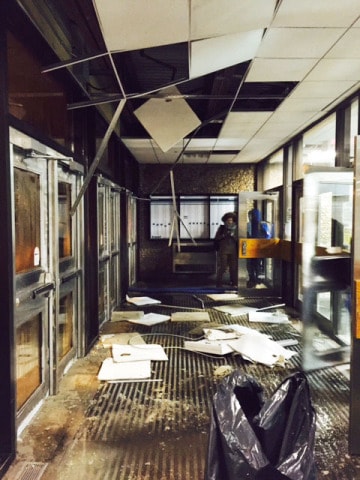 The cost of repairs for damages caused by the Jan. 5 pipe burst in upper Place Riel will not be taken out of students’ pockets.
The cost of repairs for damages caused by the Jan. 5 pipe burst in upper Place Riel will not be taken out of students’ pockets.
The flooding occurred at approximately 7:30 p.m. and was a direct result of low winter temperatures that caused a pipe to freeze and crack, allowing water to pour down between the front doors of Place Riel for nearly an hour. Full functionality has since been restored to the building.
The overall cost of the damage is still being investigated, but Stefani Ewen, facilities manager for the University of Saskatchewan Students’ Union, believes that repairs won’t be needed on as large of a scale as she initially believed.
“Everyone responded really quickly and the water was extracted immediately so the damage wasn’t as extensive as I would have thought,” said Ewen. “The state of the building was everyone’s number one priority to make sure that it was safe for students.”
The cost of the use of Saskatoon Disaster Services and the repairs required to mend the damage will be divided between the university and the USSU.
“Property insurance will cover it,” said Caroline Cottrell, general manager for the USSU. “This isn’t going to cost students money.”
Though the flooding impacted many of the university’s services, including the Campus Dentist office, the Roy Romano Council Chambers, the Food Centre, the Campus Computer Store and the women’s washrooms in lower Place Riel, Cottrell said that the situation was handled quickly and efficiently.
“If this had happened at two in the morning, it would have been much worse,” said Cottrell. “Saskatoon Disaster Services was here within an hour. We literally had a flood at 7:30 at night and by nine the next morning we could open the building again.”
Both Ewen and Cottrell agree that the flood damage wasn’t nearly as extensive as it had the potential to be. They largely attribute this outcome to the hard work and dedication of the university’s caretakers and Facilities Management Division.
“Our caretakers were rockstars,” said Cottrell. “They were literally trying to hold back the floods. The electricians, the plumbers, the repair guys, everybody just came to make sure that everything was done quickly so everyone could be here the next day.”
A contributing factor to the pipe burst could be the sprinkler system in-between the front doors of Place Riel, which is frequently exposed to freezing temperatures for much of the year.
“One of the problems with having a sprinkler system through the vestibule of Place Riel is that when you’ve got 20,000 students a day coming through that space when it’s 40 below, the doors are basically open all the time,” said Cottrell.
Services in Place Riel were back in working order on Jan. 12 with the reopening of the Campus Dentist office and the Roy Romano Council Chambers. Despite fears of equipment destruction, the Campus Computer Store escaped nearly unscathed due to the quick response of the university’s caretakers.
“I think only one box was damaged. We sent our caretakers in there and Jeff Jackson, our [Information Technologies] guy, came on site to make sure that any computer equipment that was in danger was moved,” said Cottrell. “We picked up everything that we could off the floor and sent the caretakers in to make sure that the tiles didn’t lift, so the water wasn’t standing very long.”
Though some services still require maintenance, Ewen said that the repairs that remain are minimal.
“We’re just waiting on drywall, some insulation tiling and some carpet tiles,” said Ewen.
This isn’t the first time that water has streamed through Place Riel, as the building has seen five major floods since 2007.
“Each flood has been completely unique,” said Cottrell. “The first one was really awful because we had just finished [the International Student and Study Abroad Centre] and a storm drain gave out by the library and collapsed in the rain. When we came in it was just mud — not even water — to the stairs of Place Riel. The mud was slogging into my rubber boots.”
No plans have been made to reinforce the pipes to prevent floods from occurring in the future because the Saskatchewan climate is simply so harsh and unpredictable that such situations cannot be avoided.
— With files from Anna-Lilja Dawson.
—
Photo: Stefanie Ewen